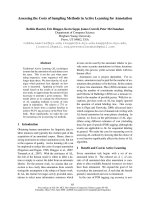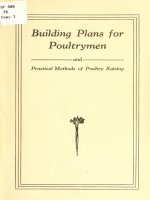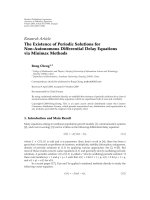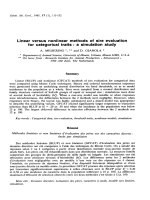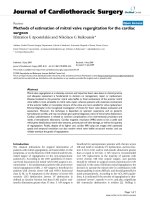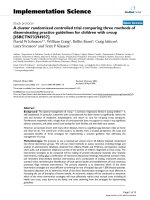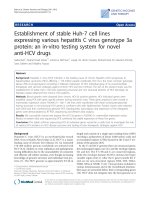ASTM D203-33 Methods of Testing Tolerances for Cotton Yarns (Withdrawn 1936)
Bạn đang xem bản rút gọn của tài liệu. Xem và tải ngay bản đầy đủ của tài liệu tại đây (378.78 KB, 5 trang )
STANDARD SPECIFICATIONS ELECTRICAL
FOR
TOLERANCES AND TEST METHODS FOR
COTION YARNS1
A.S.T.M. Designation: D 203-33
These spccifirotions nrc issm:d under Lhe fixed designation D 203; the final
number indicates the year of original adoption ns stMdard or, in the cnse of revision,
the year of last revision.
Issunn AS 'l'I!NTATIVI·:, 1924; AuOI'TRU IN AMIHIIJIW FOI(M, 1925; RRVISBD, 1933.
Scope
1. These specifications cover the tolerances and methods of
testing for electrical cotton yams, both single and multiple wound.
TOLERANCRS
Strength
2. The avemge tensile strength of each case or bale of yam, either
single or plied, as dctennincd hy test slmll be not less than the spedtied
strength.
Size or Yarn Number
3. The average size of each case or bale of yarn, in the singles,
either c..1.rdcd or combed, as determined by test slmll not be more
than 3 per cent over or under the spcdticd size.
.Kmmf1le.-No. 36 canlcd yaru specified; tolerance wou!J nllmv 34.92 lo
37.08.
Twist
4. D-ircclion of 1'wist.-The direction of twist shall be as defined
in the Tentative :Oellnitions and Terms Relating to Textile :Materials
(A.S.T.M. Designation : D 123 - 33 T) of the American Society for
Testing Materials, as follows:
Twist, Di,·cctio~t 11].-In the case of yarn or cord: the yam or cord
has right-hand or regular twist if when it is held vertically the spirals
or twists are seen to incline upward in a right·h<~nd direction and has
left-hand or reverse twist when the spirals or twists are seen to incline
upward in a left-hand direction.
NoTE.-Attention is rolled to the fact that this definition of twist is opposite
to that used in sewing thrend manufacture.
'Under tho stAndi\Cdi•.ation proco
(1171)
1172 SPECIFICATIONS FOR ELECTRICAL CoTTON YARNS
Twist of Plied Yarns
5. The average twist of each case or bale 0£ yarn, either single
or plied, as determined by test shall not be more than 5 per cent over
or under the specified twist.
Example.-Twist specified is 20 twists per inch; tolerance 19 to 21.
METHODS OF TESTING
STRENGTH
Testing Machine
6. All skeins shall be broken on an automatic power yarn tester
of inclination balance type of 150 and 300-lb. capacities. The lower
capacity should be used until the swing of the pendulum exceeds an
angle of 45 deg. from the vertical. When yarns break above this
mark, the higher capacity of testing machine should be used.
Spools
7. The spools used in holding skeins during testing shall not be
less than 1 in. in diameter, and not less than 1 in. in width. The upper
or head end spool should be fastened solidly, and the lower spool
be allowed to revolve.
Speed
8. The speed of pulling jaw shall be 12 in. per minute.
Reels
9. Any yarn reel having a 1~-yd. perimeter may be used in pre-
paring the skeins. For yarn wound on cones, where the yarn is drawn
from the top, a speed of 100 to 300 r.p.m. of reel shall be used. For
yarn wound on parallel tubes, the yarn shall be drawn from the side,
and a speed of 20 to 30 r.p.m. of reel shall be used. On reels that have
only one pigtail guide and for yarns on cops or cones, either single
TABLE I,
NUMBER OF ENDS IN LENGTH TO REEL
SINGLE STRAND FOR TEST, YO,
2.......................................................... 60
3.......................................................... 45
4 and 5................................................. '.... 30
6 and 7..................................................... 21
8 and above......... . . . . . . . . . . . . . . . . . . . . . . . . . . . . . . . . . . . . . . . . 15
end or multiple wound, the tension shall be applied by making one full
wrap around the guide. For yarns on parallel tubes, either single end
or multiple wound, there shall be no wraps around the guide. On
reels using two or more guides, the yarn, either single end or multiple
wound, shall pass straight through the guides onto the reel, the angles
of the guides supplying the necessary tension. Judgment must be
A.S.T.M. DESIGNATION: D 203-33 1173
used in regard to the amount of tension required on yarns having little
or a large amount of twist.
Number of Tests
10. Three .tests from each of four cops, cones or tubes of yarn
from every case shall be made, and the average of these twelve tests
shall be the average of the case.
Two skein test methods are given, A, Preferred Method and B, Alternate
Method. The Alternate Method can be used where routine testing is done on
a large scale. The Preferred Method should always be used in case of dispute.
A. Preferred Method
Strength, Single End Yarn
11. For single end yarn a standard skein (120 yd.) shall be broken
after conditioning in an atmosphere of 65 per cent relative humidity,
and 70° F. (21 ° C.).
Strength, Multiple Wound Yarns
12. For multiple wound yarn, a skein shall be prepared in accord-
ance with Table I, and shall be broken after conditioning in an atmos-
phere of 65 per cent relative humidity, and 70° F. (21 ° C.). The
table provides for skeins of approximately 120 yd. of single yarn or
80 loops. No skeins shall be less than 10 loops or 15 yd. of multiple
strand.
Conditioning
13. Cops, cones and tubes selected for test shall be conditioned
for at least 12 hours. Yarn removed for testing after conditioning
shall not penetrate into a tube a distance of more than !- in. on a radial
line. Skeins shall be conditioned for at least 3 hours.
B. Alternate Method
Strength, Single
14. Skeins of either single end or multiple wound yarn prepared
as outlined in Method A shall be broken under natural humidity
conditions at the time of test. The results thus obtained shall be
reduced to a common basis of standard moisture regain equal to
7 per cent of the bone-dry weight.
Moisture Regain DetermiD.ation
15. To determine moisture regain present in samples, the several
skeins shall be weighed collectively, immediately after testing, under
natural moisture conditions which obtain at the time of test. The
skeins shall then be p)aced in the basket of an oven at a temperature
of 105 to 110° C. (221 to 230° F.) and dried to constant weight. The
moisture regain is then computed as the percentage of the dry weight.
S II-76
117 4 SPECIFICATIONS FOR ELECTRICAL COTTON YARNS
Correction to Standard Regain
16. The following formula shall then be applied, based on the
assumption that the standard moisture regain of cotton yarns is 7
per cent of the dry weight, that the actual percentage regain is between
the limits of 3 and 7 per cent of the dry weight, and that for 1 per cent
of moisture regain there is an increase of 6 per cent in the tensile
strength of the yarn:
(Tensile strength from machine read-
Tensile strength corrected to ing) X 142
standard moisture regain = 100 + (6 X actual percentage regain)
Example.-With a skein of yarn broken under natural conditions showing
a tensile strength of 120 lb. as read from the machine dial and which by weighing
before and after drying the skein was found to contain a moist\lre regain equal
to 5 per cent of the bone-dry weight, the tensile strength corrected to a common
basis of 7 per cent moisture regain would be:
Corrected tenstle strength =. 120 X 142 ) = 131lb.
. 100 + (6 X 5
(b) Moisture regain tests shall be made periodically during the
hours of testing as the natural humidity conditions are found to vary.
C. Strength Correction to Size
Strength Correction to Size
17. The average tensile strength shall be corrected to the specified
size as determined in accordance with Sections 18 and 19 by the fol-
lowing formula:
Corrected tensile strength = Actual average strength X Actual average size
. .
Specified s1ze
Yarn Number, Preferred Method
18. All skeins used in the Preferred Method of testing for strength
shall be sized immediately after being broken.
Yarn Number, Alternate Method
19. All skeins used in the Alternate Method of testing for
strength shall be sized under natural humidity conditions at the time
of test. The moisture regain shall then be determined as outlined in
Section 15 and the results corrected to a common basis of standard
moisture regain equal to 7 per cent of the bone-dry weight by means
of the following formula: ·
Size corrected to standard Size X (100 +actual percentage of regain)
moisture regain 107
Balance
20. The balance to be used shall be accurate to 0.25 per cent of
the standard size of the yarn. When the balance does not indicate
A.S.T.M. DESIGNATION: D 203- 33 1175
the size directly, the yarn number or size may be calculated from the
formula:
Length in yards of
Yarn number or size = single yarn 7000 (grains in I lb.)
Weight in grains X 840 (yards of No. I cot-
ton yam per pound)
Number of Tests
21. The average size of the,12 skeins used in the strength test shall
be the average size of case or bale.
Twist
22. (a) Single Twist.-The single yarn twist shall be determined
on any standard single yarn twist tester employing the principle of
first taking the twist out of a given length of yarn and then retwisting
in the opposite direction until the same amount of twist is put back,
dividing the results by twice the distance between grips to get the
twists per inch. The minimum distance between jaws shall be 5 in.,
but a 10-in. distance is preferable. In making this test it is essential
that check tests be made before proceeding with regular tests in order
to determine the proper tension to be placed on the yarn so as not
to cause slippage of the fibers and other variations.
(b) Ply Twist.-The ply twist in yarns of two or more ply shall
be determined on any standard twist counter with jaws set 10 in.
apart. The strands shall be clamped in jaws under a definite tension
by attaching weights. The tension to be used shall be determined
from the formula:
!56 (Constant)
Tension, in grams = ------"---
Equivalent singles size
Example.-The weight for 80/2 ply would be as follows.
1:~ = 3.9 g. (approximately)
NoTE.-The constant of 156 represents a tension (basis yarn No. 1) which
should be placed on yarn or cord to hold it sufficiently taut and still not remove any
stretch. ·
Number of Twist Tests
23. (a) Single Yarns.-Three twisftests on each of ten packages
of single yarn from each case or bale shall be made, and the average
of these 30 tests shall be the average twist of the case or bale.
(b) Plied Yarns.-Three twist tests on each of four packages of
plied yarn from each case or bale shall be made, and the average of
these 12 tests shall be the average twist of the case or bale.

